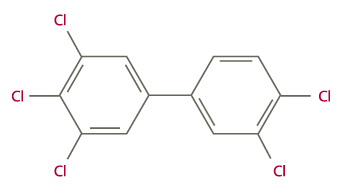Laboratory
High Resolution Mass Spectrometry (HRMS)
Jun. 12 2006
Polychlorinated biphenyls (PCBs) are a family of synthetic organic chemicals that were introduced in the 1940s for a variety of purposes. Normally a liquid, PCBs have properties of non-flammability, chemical stability, high boiling points, and electrical insulation. As a result, PCBs were used in hundreds of industrial and commercial applications including electrical insulation and heat transfer liquids, hydraulic equipment and plasticizers. More than 1.5 billion pounds of PCBs were manufactured in the United States prior to cessation of its production in 1977.
PCBs are biphenyls with varying degrees of chlorine substitution on the biphenyl ring. The amount of chlorine substitution and the location of the chlorine(s) on the biphenyl ring are used to describe these molecules. Each possible configuration is referred to as a congener. There are 209 possible PCB congeners that are all toxic chemicals; see Figure 1 as an example. Banned for commercial use, they are subject to considerable environmental and health regulations throughout the world.
Figure 1: 3,3’,4,4’,5 Pentachlorobiphenyl (PCB-126)
In addition, the World Health Organization (WHO) has designated a series of twelve individual congeners as being “dioxin-like” in their potential health effects. Dioxins and furans are among the most toxic chemicals known. The dioxin-like PCBs shown in Table 1 exhibit increased toxicity compared to other PCB congeners.
Toxic Equivalency Factors
The dioxin-like PCB congeners have been shown to produce health effects similar to those of 2,3,7,8-tetrachlorodibenzop-dioxin (TCDD), the most toxic dioxin. These include neuro-developmental effects, immunotoxicity, reproductive effects or teratogenicity, endocrine disruption and some forms of cancer. Under WHO, the dioxin-like PCB congeners have been assigned 2,3,7,8-TCDD Toxicity Equivalency Factors (TEFs), indicating their toxicity relative to 2,3,7,8-TCDD, which itself has been assigned a TEF of 1.0. For example, a PCB congener with a TEF of 0.01 is considered to be one hundred times less toxic than 2,3,7,8-TCDD.
Our HRMS Laboratories
Bureau Veritas’ ISO 17025 certified HRMS laboratories provide accredited ultratrace analytical testing services globally for compounds such as polychlorinated dibenzo(p) dioxins, polychlorinated dibenzofurans (PCDDs/PCDFs), and polychlorinated biphenyl (PCB) congeners.
Analytical Methods
The methods used at Bureau Veritas’ HRMS facility are designed to identify and quantify ultratrace levels of dioxin-like PCB congeners in liquid, solid, air, and biota. Our analytical procedures are based on USEPA Method 1668, versions A, B and C.
The typical analytical process includes:
- Fortification of the sample with isotopically labeled surrogate standards.
- Solvent extraction.
- Application of a multi-component clean-up of the extract.
- Analysis by selected ion monitoring High Resolution Gas Chromatography / High Resolution Mass Spectrometry (HRGC/HRMS).
Table 1: Dioxin-like PCB Congeners [1]
| BZ, IUPAC NAME AND IUPAC NUMBER | CAS NUMBER |
|---|---|
| PCB-77 3,3’,4,4’-Tetrachlorobiphenyl | 32598-13-3 |
| PCB-81 3,4,4’,5-Tetrachlorobiphenyl | 70362-50-4 |
| PCB-105 2,3,3’,4,4’-Pentachlorobiphenyl | 32598-14-4 |
| PCB-114 2,3,4,4’,5-Pentachlorobiphenyl | 74472-37-0 |
| PCB-118 2,3’,4,4’,5-Pentachlorobiphenyl | 31508-00-6 |
| PCB-123 2’,3,4,4’,5-Pentachlorobiphenyl | 65510-44-3 |
| PCB-126 3,3’,4,4’,5-Pentachlorobiphenyl | 57465-28-8 |
| PCB-156 2,3,3’,4,4’,5-Hexachlorobiphenyl | 38380-08-4 |
| PCB-157 2,3,3’,4,4’,5’-Hexachlorobiphenyl | 69782-90-7 |
| PCB-167 2,3’,4,4’,5,5’-Hexachlorobiphenyl | 52663-72-6 |
| PCB-169 3,3’,4,4’,5,5’-Hexachlorobiphenyl | 32774-16-6 |
| PCB-189 2,3,3’,4,4’,5,5’-Heptachlorobiphenyl | 39635-31-9 |
Table 2: WHO 2005 Toxicity Equivalence Factors (TEFs) [2]
| BZ / IUPAC # | IUPAC PREFIX | HUMAN / MAMMAL | FISH | BIRD |
|---|---|---|---|---|
| PCB-77 | 3.3’,4,4’-Tetra | 0.0001 | 0.0001 | 0.05 |
| PCB-81 | 3,4,4’,5-Tetra | 0.0003 | 0.0005 | 0.1 |
| PCB-105 | 2,3,3’,4,4’-Penta | 0.00003 | <0.000005 | 0.0001 |
| PCB-114 | 2,3,4,4’,5-Penta | 0.00003 | <0.000005 | 0.0001 |
| PCB-118 | 2,3’,4,4’,5-Penta | 0.00003 | <0.000005 | 0.00001 |
| PCB-123 | 2’,3,4,4’,5-Penta | 0.00003 | <0.000005 | 0.00001 |
| PCB-126 | 3,3’,4,4’,5-Penta | 0.1 | 0.005 | 0.1 |
| PCB-156 | 2,3,3’,4,4’,5-Hexa | 0.00003 | <0.000005 | 0.0001 |
| PCB-157 | 2,3,3’,4,4’,5’-Hexa | 0.00003 | <0.000005 | 0.0001 |
| PCB-167 | 2,3’,4,4’,5,5’-Hexa | 0.00003 | <0.000005 | 0.00001 |
| PCB-169 | 3,3’,4,4’,5,5’-Hexa | 0.03 | 0.00005 | 0.001 |
| PCB-170 | 2,2’,3,3’,4,4’,5-Hepta | - | - | - |
| PCB-180 | 2,2’,3,4,4’,5,5’-Hepta | - | - | - |
| PCB-189 | 2,3,3’,4,4’,5,5’-Hepta | 0.00003 | <0.000005 | 0.00001 |
For more information, please contact:
ultratrace@bvlabs.com
Or 1.800.563.6266
References
[1] Ballschmitter, K. and Zell, M.: Analysis of polychlorinated biphenyls (PCB) by glass capillary gas chromatography. Fresenius Z. Anal. Chem. 302:20-31. 1980.
[2] The 2005 World Health Organization Re-evaluation of Human and Mammalian toxic equivalency factors for dioxins and dioxin-like compounds
